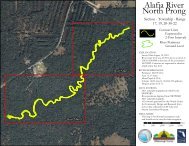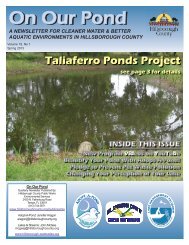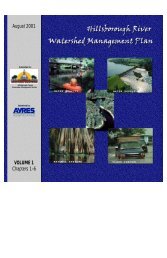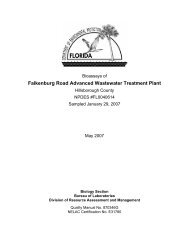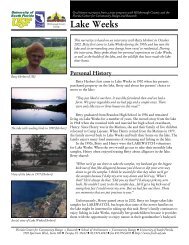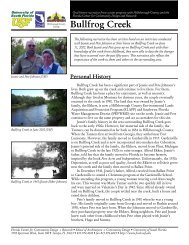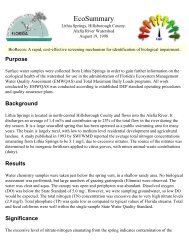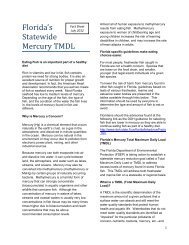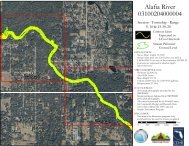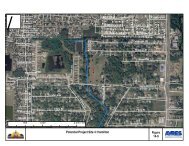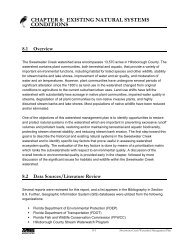Rocky Brushy Creek Watershed Mgmt. Plan (2007) -- Part 2
Rocky Brushy Creek Watershed Mgmt. Plan (2007) -- Part 2
Rocky Brushy Creek Watershed Mgmt. Plan (2007) -- Part 2
Create successful ePaper yourself
Turn your PDF publications into a flip-book with our unique Google optimized e-Paper software.
EXISTING NATURAL SYSTEMS CONDITIONS8.4.1 Upland Natural SystemsThe following upland habitat descriptions are based on the information contained in Harper (1921),Carlisle et al. (1978), Florida Department of Transportation’s FLUCFCS Manual (1999), and theSoil Surveys of Hillsborough County from 1916, 1958, and 1989. In the plant communitydescriptions below, only the species that are most characteristic of the plant community in the<strong>Rocky</strong>/<strong>Brushy</strong> <strong>Creek</strong> watershed are mentioned as being present; however, the natural plantcommunities that still remain in the watershed are highly diverse and contain many more speciesthan are mentioned in this report. For ease of reading, only common names of plants are used inthe report narrative, but Section 8.10 provides a list of all scientific names of plants and animalsincluded in the report.Pine flatwoods (411)The most common upland plant community in the state and in the <strong>Rocky</strong> <strong>Creek</strong> - <strong>Brushy</strong> <strong>Creek</strong>watershed is the pine flatwoods community which is associated with Malabar fine sands andImmokalee fine sands. The primary canopy species common to pine flatwoods is slash pine withsome longleaf pine, while the shrubby understory is dominated by saw palmetto with somegallberry, staggerbush, blueberry, and tarflower. Herbaceous ground cover is sparse and includeswiregrass, several species of bluestem, and goldenrod. This community occurs on flat, moderatelyto poorly drained terrain composed of acid sands overlying an organic/clayey hardpan. Even onbetter drained terrain, flatwoods can experience periods of inundation when rainfall amounts are inthe normal to above normal range. On less well drained terrain, a wet phase of pine flatwoodsoccurs in which obligate to facultative-wet plant species can be found flatwoods regularly. Thesespecies include trees: sweetbay, gordonia, red maple; shrubs: wax myrtle, gallberry, fetterbush;and herbs: spikerush, redroot, bog buttons, pink sundews, and yellow-eyed grass. Pine flatwoodsis a fire-maintained community that will transition to a hardwood-dominated community with verydense canopy dominated by live oak, laurel oak, and pignut hickory if fire is excluded. In the <strong>Rocky</strong><strong>Creek</strong> - <strong>Brushy</strong> <strong>Creek</strong> watershed, pine flatwoods have been used for pasture, row crops, and (withdrainage) some citrus. Pine flatwoods now occupies only 1% of the watershed.Longleaf pine-xeric oak (412)The longleaf pine - xeric oak plant community, also known as sandhill, is associated with Norfolkfine sands in the <strong>Rocky</strong> <strong>Creek</strong> - <strong>Brushy</strong> <strong>Creek</strong> watershed. Natural canopy vegetation is dominatedby longleaf pine, and characteristically has a mid-canopy of bluejack oak, turkey oak, sand liveoak. The understory contains a medium to low density shrub community consisting of shinyblueberry, Darrow’s blueberry, gopher apple, Adam’s needle, and beautyberry. Herbs compose theground cover and include: wiregrass, sky-blue lupine, drumheads, Carolina elephant’s foot, dwarfpawpaw, and eastern milk pea. This community also is a fire-maintained community that willtransition to a hardwood-dominated community with few to no pines and a very dense canopydominated by sand live oak, turkey oak, bluejack oak if fire is excluded. This plant community waslargely replaced by citrus by 1950. Currently (2004), this community occupies 0.3% of thewatershed.8-8<strong>Rocky</strong>/<strong>Brushy</strong> <strong>Creek</strong> <strong>Watershed</strong> Management <strong>Plan</strong>



